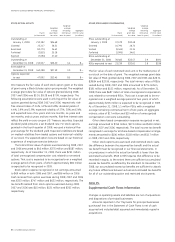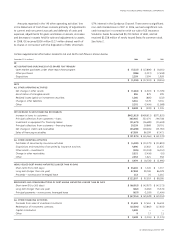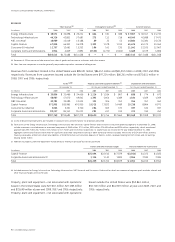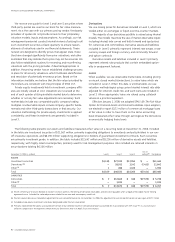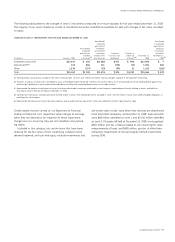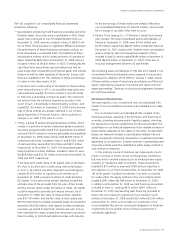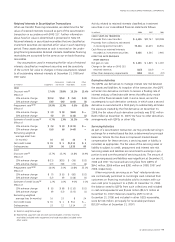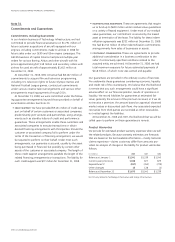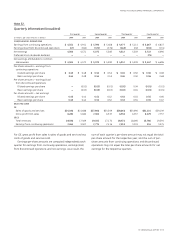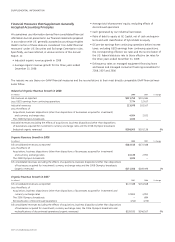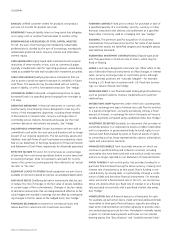GE 2008 Annual Report Download - page 98
Download and view the complete annual report
Please find page 98 of the 2008 GE annual report below. You can navigate through the pages in the report by either clicking on the pages listed below, or by using the keyword search tool below to find specific information within the annual report.
96 ge 2008 annual report
notes to consolidated financial statements
Counterparty Credit Risk
We manage counterparty credit risk, the risk that counterparties
will default and not make payments to us according to the terms
of the agreements, on an individual counterparty basis. Thus,
when a legal right of offset exists, we net certain exposures by
counterparty and include the value of collateral to determine the
amount of ensuing exposure. When net exposure to a counter-
party, based on the current market values of agreements and
collateral, exceeds credit exposure limits (see following table), we
take action to reduce exposure. Such actions include prohibiting
additional transactions with the counterparty, requiring collateral
from the counterparty (as described below) and terminating or
restructuring transactions.
Swaps are required to be executed under master agreements
containing mutual credit downgrade provisions that provide the
ability to require assignment or termination in the event either
party is downgraded below A3 or A–. In certain cases we have
entered into collateral arrangements that provide us with the right
to hold collateral (cash or U.S. Treasury or other highly-rated
securities) when the current market value of derivative contracts
exceeds a specified limit. We evaluate credit risk exposures and
compliance with credit exposure limits net of such collateral.
Fair values of our derivatives can change significantly from
period to period based on, among other factors, market move-
ments and changes in our positions. At December 31, 2008,
our exposure to counterparties, after consideration of netting
arrangements and collateral, was about $1,800 million.
Following is GECS policy relating to initial credit rating
requirements and to exposure limits to counterparties.
COUNTERPARTY CREDIT CRITERIA
Credit rating
Moody’s S&P
Foreign exchange forwards and other
derivatives less than one year P–1 A–1
All derivatives between one and five years Aa3 (a) AA– (a)
All derivatives greater than five years Aaa (a) AAA (a)
(a) Counterparties that have an obligation to provide collateral to cover credit
exposure in accordance with a credit support agreement must have a minimum
A3/A– rating.
EXPOSURE LIMITS
(In millions)
Minimum rating Exposure(a)
Without
With collateral collateral
Moody’s S&P arrangements arrangements
Aaa AAA $100 $75
Aa3 AA– 50 50
A3 A– 5 —
(a) For derivatives with maturities less than one year, counterparties are permitted to
have unsecured exposure up to $150 million with a minimum rating of A–1/P–1.
Exposure to a counterparty is determined net of collateral.
Note 30.
Off-Balance Sheet Arrangements
We securitize financial assets and arrange other forms of asset-
backed financing in the ordinary course of business to improve
shareowner returns. The securitization transactions we engage in
are similar to those used by many financial institutions. Beyond
improving returns, these securitization transactions serve as
funding sources for a variety of diversified lending and securities
transactions. Historically, we have used both GE-supported and
third-party Variable Interest Entities (VIEs) to execute off-balance
sheet securitization transactions funded in the commercial paper
and term markets.
Investors in these entities only have recourse to the assets
owned by the entity and not to our general credit, unless noted
below. We did not provide non-contractual support to consoli-
dated or unconsolidated VIEs in either 2008 or 2007. We do not
have implicit support arrangements with any VIEs.
Variable Interest Entities
When evaluating whether we are the primary beneficiary of a
VIE and must therefore consolidate the entity, we perform a
qualitative analysis that considers the design of the VIE, the
nature of our involvement and the variable interests held by
other parties. If that evaluation is inconclusive as to which party
absorbs a majority of the entity’s expected losses or residual
returns, a quantitative analysis is performed to determine who is
the primary beneficiary. The largest single category of VIEs that
we are involved with are Qualifying Special Purpose Entities
(QSPEs), which meet specific characteristics defined in U.S. GAAP
that exclude them from the scope of consolidation standards.
Consolidated Variable Interest Entities
Upon adoption of FIN 46 and FIN 46(R) on July 1, 2003 and
January 1, 2004, respectively, we consolidated certain VIEs with
$54.0 billion of assets and $52.6 billion of liabilities, which are
further described below. At December 31, 2008, assets and
liabilities of those VIEs, and additional VIEs consolidated as a
result of subsequent acquisitions of financial companies, totaled
$26,626 million and $21,256 million, respectively (at December 31,
2007, assets and liabilities were $32,382 million and $24,342 million,
respectively).


